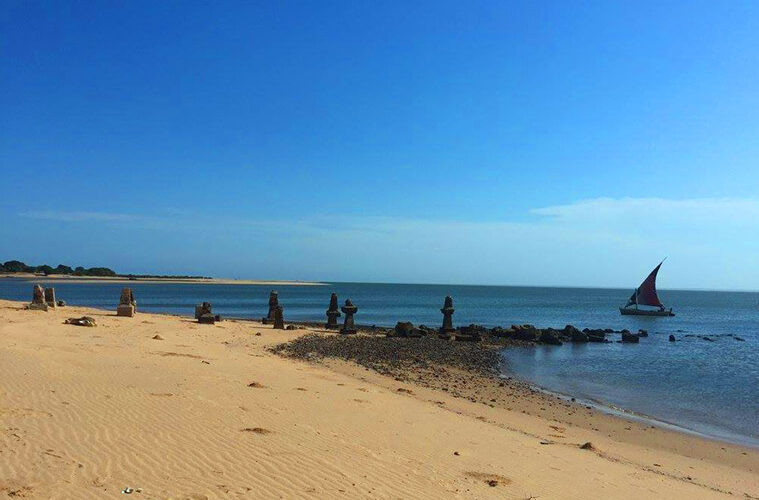Mozambique has got many treasures around its shores, in the middle of the ocean, and Xefina Island tour allows You to explore one of them. Many people see the island from the main sea road, and all they wonder if it is possible to visit, as it seems close to the continent, even reachable by swimming, but the true is you need a boat. You will find some locals living there from goats, hens and fishing. The beach is entirely for your own entertainment, so do the sea. And we will take you for a walk around the island to show Mozambique’s past. Come and explore this virgin island!
We will wait for you at Porto da Pesca to start the adventure of our Xefina Island Tour. Time will depend on the tides, so we will always confirm in advance. Bring everything you need for a day in the beach.
We will use the old harbor of Xefina for landing and we will set our campsite there: our tables, chairs, shadow, fridges, etc. Feel free to go around as we will take care of your items.
If you love music, bring you JBL and enjoy the day with your favourite songs and lyrics of the sea.
Flamingos sometime appear around, and crabs as well. You will feel like Robinson Crusoe in the middle of nowhere.
At any time you wish, we will join you for a walk all along the island, as the east side has historical parts you cannot lose.
Your day will be just perfect.
A few kilometres off the coast from Maputo lies the tantalizing and enigmatic island in the middle of the Indian Ocean called Xefina Island. We will take you to this beautiful and untouched wonder in a private speed boat.
The Xefina Island Tour starts and ends at the habour (Porto da Pesca) and includes everything: Mussiro’s host/guide, boat, entrance fees, shadow, chairs, table, picnic lunch, drinks and water, cooler box with ice that you can use for your extra drinks. Please bring swimming clothes, beach shoes, towels, sunscreen, hat/cap, extra drinks or your special food.
We depart from the harbour at around 8 a.m. –please note that the departing time depends with the tides on that day, but don’t worry, we will keep you informed day before about the start of the trip. We will be waiting for you at Porto da Pesca to start our adventure.
Xefina Island is 12 kilometres from the Catembe ferry dock, so just 15 minutes boat ride from Maputo, but just 5 km from Costa do Sol, where the island is facing to.
On arrival to Xefina Island we will probably use the old harbour for landing, but once again, this will depend on tides and also on our skipper. And you will directly get in contact with history if we use this old harbour, as has been embraced by time and erosion and never rebuilt again.
This Island has a long history as a Portuguese trading base, prison and war garrison, indeed it serves as an ivory trading post, penal colony and a military installation. Of interest are the ruins of the old Portuguese fort and the rusty remains of the battery of heavy canons that guarded the entrance to the harbour during the World War II, built on a sand dune which has since been eroded by the lapping waves; the guns have slid down the dune into the sea. Visiting these ruins, swimming and picnicking are the main diversions.
Xefina is one of a few great escapes from the capital city, Maputo. The island boasts more of a historical feel as it is less travelled and more frequently by fisherman. In the 19th century it was used as a leper colony, then early in the 20th century the Portuguese built an army base and fort with the aim of protecting the city of Maputo (during the first and second World Wars) as all ships must arrive through the channel between Inhaca Island and Xefina Island. The old prison Island holds deep stories and can be viewed clearly from the shore.
After landing our team will set up our day camp, the shadow, tables and chairs, you can have some snacks, water or soft drinks when you need, just let our team knows, it’s your day! You can swim, do a walk around the Island whilst learning the history of this virgin Island, or just do sun bathing, listen to music (if you are music lover bring a LBJ speaker for playing music) or read a book. Mainly animals you can see sometimes depends with the season: flamingos, crabs and egrets.
Flamingos are a type of wading bird, and they are four species of Flamingos in America and two types in Africa. Flamingos are often stand on one leg to preserve body heat, tucking the other leg into their plumages so that it is kept warm. They like so much foods like shrimps and snails; these foods have a chemical that turns a flamingo’s feathers pink. The more of these chemicals they eat, the stronger the colour of their feathers. That’s why flamingos in some parts of the world are brighter than others. Baby Flamingos are called chicks, but others called them sparks since the adults are named after flames. Flamingo eggs yolks are yellow or orange although some are pink, this is also due to the chemicals in the food they eat. When Flamingos migrate, they do so mainly at night, they prefer to fly with a cloudless sky and favourable tailwinds. They can travel approximately 600 km in one night; on the other hand, when travelling during the day, the flamingos fly at high altitudes, possibly to avoid predators like eagles. It is believed that flamingos are monogamous, once they mate they tend to stay with that mate. A group of flamingos will all mate at the same time so that all the chicks will hatch at the same time.
Flamingos live up to 20 to 30 years in the wild and up to 50 years in zoo. They also have long, curved necks and black-tipped bills with a distinctive downward bent. Their bent bills allow them to feed on small organisms, like plankton, tiny fish and webbed feet are used to stir up the bottom water.
If you take a walk around the Island you see a lot of crabs on the shores. Crabs typically have a very short projecting tail, usually hidden entirely under the thorax. They live in all the world’s oceans, in fresh water, and on land. Generally they are covered by an exoskeleton that protects their soft tissue and have a single pair of pincers. There are more than 4,500 species of crabs in the world, most species live in coastal areas of salty, fresh or brackish water, crabs are super old. They showed up 200 million years ago. The pea crab is the smallest crab in the world and the Japanese spider crab is the biggest one. Crabs walk and swim sideways, they eat both meat and plants making them omnivores, the females only have pregnancy for one or two weeks and they lay between 1000 and 2000 eggs.
Groups of crabs living together are called as “casts”. The average lifespan of crabs is 3 to 4 years, Crabs are known as “spiders of the sea” because like crabs, spiders have legs that bend at joints. All crabs have claws on their two front legs. They have around 10 eyes that help them to get around; these eyes are distributed around the body including on top of its shell, on the tail and near the mouth to help orient the animal when swimming. Two compound eyes are easily seen on each side of the animal’s shell. Crabs are mostly active animals with complex behaviour patterns, they can communicate by drumming or waving their pincers, they are known to work together to provide food and protection for their family, and during mating season to find a comfortable spot for the female to release her eggs. Most crabs walk or run across the ocean bottom, some such as the commercially caught blue crab of the Atlantic coast is a member of the family of swimming crabs which can swim, their rearmost pair of legs is modified for swimming and legs are paddle-shaped. In the wild crabs can live their life for up to 30 years, hence in captivity they live much shorter life not even reaching 1 year.
Very few people live on the Xefina Island, only fisherman whose lives depends on fishing, keeping few goats and chicken as well for living. At this Island there is not enough fresh water for drinking, so people are forced to transport their drinking water from mainland in Maputo.
If you are a music lover, please bring some portable speakers or just enjoy the music and lyrics which comes from the sea as we do. 😀
We will serve a light picnic lunch on the beach at the time you choose. Have lunch enjoying the view of Costa do Sol-Maputo from the other side. After lunch you can have a nap, read a book or sunbath, after lunch you can have more time to explore and enjoy.
Birds like egrets are sometimes seen on the shore looking for a meal from small crabs and small fishes. Egrets are small popular white birds, mainly they are seen following livestock animals like cattle or goats or wild animals like buffalos; they are known for its perceived role as a biocontrol of animal parasites such as ticks and flies.
On Xefina Island we have also seen the biggest jellyfishes on the shores, and we advise you not to touch any, you can get close and take photos. Jellyfish has no brain, no heart, bones or eyes, they are made up of a smooth, bag-like body and tentacles armed with tiny, stinging cells. These incredible invertebrates use their stinging tentacles to stun or paralyse prey before gobbling it up. The jellyfish mouth is found in the centre of its body. Some jellyfish have bioluminescent organs which emit light. This light may help them in a number of different ways, like attracting prey or distracting predators. If a jellyfish is cut into two, the pieces of the jellyfish can regenerate and create two new organisms. Jellyfish can teach us about efficient underwater propulsion.
The movements of bell-shaped jellyfish have provided researchers with a new understanding of propulsion, this is the flexibility of their umbrella-like bodies allow them to pulse upwards and downwards without expending much energy. It is said that the jellyfish is quickly taking over the ocean. Despite their name, jellyfish are actually not fish, jellyfish are made up of over 95% water, and they are related to corals and anemones.
We will depart Xefina at any time when you decide to, as it is a 15 minutes boat ride, but one more time, we will listen to our skipper and his knowledge about tides to know when we should leave. 😀
Our tour will end at Porto da Pesca.
Do not hesitate to give us a call or send a message. We are looking forward to help you out ☺

